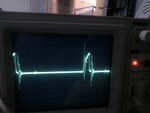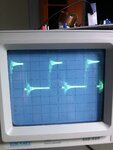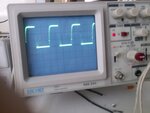tictac
Full Member level 5

Hi
I want to build the high voltage smps with the output voltage at about 30KV and maximum current= 20mA with L6599
For disabling standby mode I connect pin5 to pin4 .
For disabling current sense I connect pin6 to GND .
VCC(L6599_PIN 12)=15.3 volt , It supplied from one 15volt transformer.
I have a problem for driving high side mosfet(IRFP460 or IRF840) .
The gate resistor is 47 ohm , boot strap capacitor is about 100nF . The wave form of the low side mosfet's gate source is good (50% duty cycle and the clean square wave form- 15volts range) but the wave form of the high side mosfet's gate source is not good( 20% duty cycle, very noisy wave form- 10 volts range) . It makes the high side mosfet get too hot and burned after some minutes( even if it doesnt connect to the high voltage transformer ).
I attach the schematic of my circuit and the wave form of the high side mosfet's gate source.

Please help me for improving high side mosfet's gate source
Regards
Hamed.
I want to build the high voltage smps with the output voltage at about 30KV and maximum current= 20mA with L6599
For disabling standby mode I connect pin5 to pin4 .
For disabling current sense I connect pin6 to GND .
VCC(L6599_PIN 12)=15.3 volt , It supplied from one 15volt transformer.
I have a problem for driving high side mosfet(IRFP460 or IRF840) .
The gate resistor is 47 ohm , boot strap capacitor is about 100nF . The wave form of the low side mosfet's gate source is good (50% duty cycle and the clean square wave form- 15volts range) but the wave form of the high side mosfet's gate source is not good( 20% duty cycle, very noisy wave form- 10 volts range) . It makes the high side mosfet get too hot and burned after some minutes( even if it doesnt connect to the high voltage transformer ).
I attach the schematic of my circuit and the wave form of the high side mosfet's gate source.

Please help me for improving high side mosfet's gate source
Regards
Hamed.
Attachments
Last edited by a moderator:









